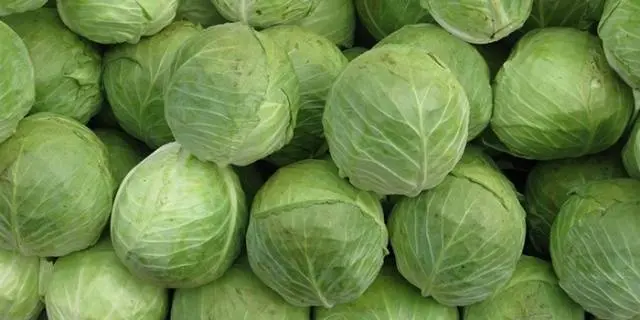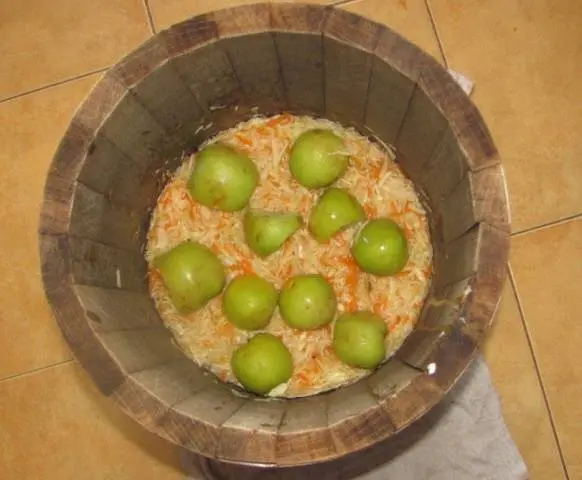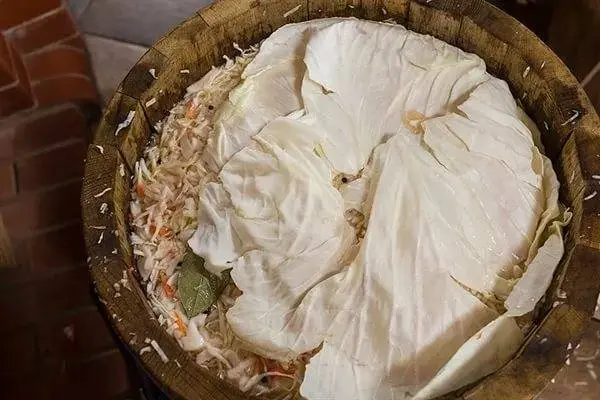Contents
Salting cabbage for the winter begins in late October, early November. For these purposes, various containers are used. Today, more and more housewives prefer to salt vegetables in jars or pans. But more recently, barrels were used. The best option is an oak container.
The sizes of barrels for salting cabbage can be selected based on the needs of the family. Vegetables salted in such a wooden container are much more appetizing. In addition, all useful properties are fully preserved in them. We will try to tell our readers about the rules of salting in a barrel.
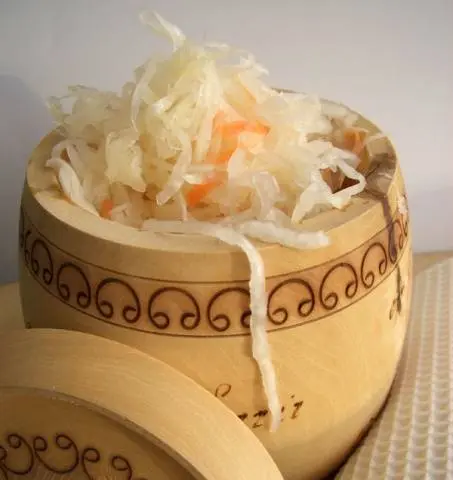
Salting Secrets
Each family has its own recipes for pickling cabbage in a barrel. Many of them are preserved for many generations.
But no recipe will allow you to get a delicious cabbage if you do not know some secrets:
- For salting, medium and late-ripening varieties are used. Early cabbage is not suitable for this purpose, as it turns out soft.

- Crispy cabbage requires the use of not iodized, but best of all rock salt. Iodine softens vegetables, making products unsuitable for consumption.
- You can salt cabbage in your own juice or in brine. Here, too, there are highlights. For brine, seasoning consumption is 30 grams per liter of water. Dry salting – 60 grams of salt for every kilogram of white vegetable.
- Fragrant crispy cabbage can be seasoned with cloves, allspice and black peppercorns, caraway seeds.
- Pickles can be varied with additives, such as apples and beets, cranberries, lingonberries and carrots. With carrots and beets, the cabbage will be orange or red. And apples and berries will add piquancy.

- Salt is best in an oak barrel. The finished product is much tastier and more aromatic.
- Pickled vegetables should be kept at room temperature for at least two weeks, and then lowered into the cellar for storage for the winter.
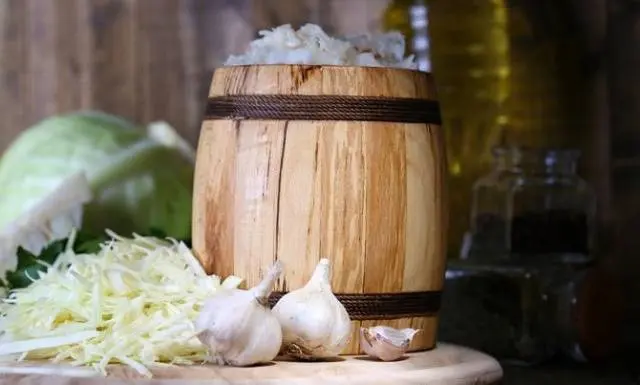
Rules for laying vegetables
Our grandmothers knew well how to salt cabbage in a barrel. In addition to the fact that they specially prepared the container, they also stacked vegetables in a special way:
- At the bottom of the barrel, in order to preserve the taste, they poured a little rye flour and covered it with cabbage leaves. They were also placed on top of the salting under the plank.
- Vegetables were laid out in a special order in layers. First, prepared cabbage, then poured salt, and only then grated carrots. You can mix vegetables and lay in a barrel after grinding.

- Each layer was tamped with a fist or pestle until the juice appeared.

- The oak barrel was not filled to the top, leaving room for the brine to be released. The top was covered with cabbage leaves.

- A barrel of salted vegetables was always covered with a linen cloth, and from time to time the contents of the barrel were pierced with a sharp twig.
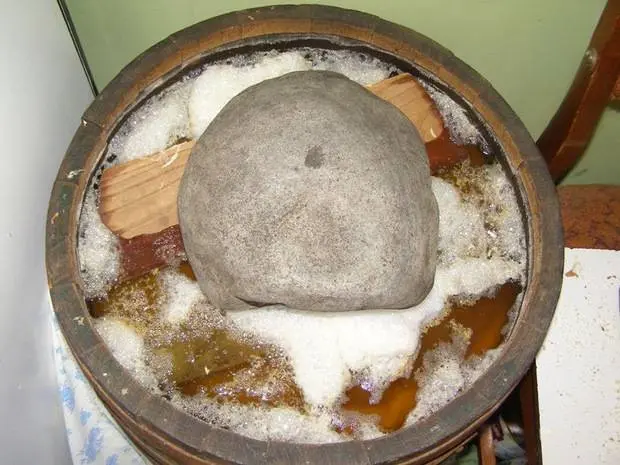
These are the important secrets of salting in a barrel for the winter, which will help you get a crispy and fragrant product rich in vitamins and nutrients.
Salting cabbage
And now about how to salt the cabbage in a barrel. As we have said, there are many interesting recipes. We will focus on a few.
Option One
According to the classic recipe, we need the following ingredients:
- tight forks – 10 kg;
- carrots – 300-400 grams;
- cranberries – 200 grams;
- coarse salt without additives – 250 grams.
As a rule, 1 heaping tablespoon of salt is taken per kilogram of cabbage.
According to the rules, one carrot is taken per fork of medium size. But lovers of orange salted cabbage can take a little more grated carrots.
We crush vegetables in a barrel, put a plank on top and oppression on top. As a rule, it is a cobblestone, washed and doused with boiling water. All other actions are performed traditionally.
Option two
Pickled whole heads in a barrel are a great product. Such cabbage can be cut for salads. And what delicious cabbage rolls are obtained!
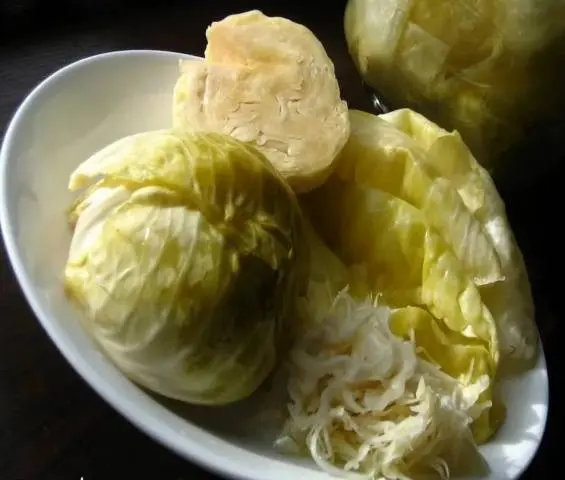
Such pickles are poured with brine: 10 grams of large non-iodized salt are taken for 400 liters of water.
How to cook
- For pickling cabbage with forks, choose cabbage only with snow-white leaves. Remove the top leaves from the heads. We put the whole ones on the table, as they are useful for lining the bottom of the barrel, filling the voids between the heads and covering the cabbage from above.
- Cut the stalks from the heads of cabbage and lay them in layers. Between the cabbage we place carrots, cut into large sticks or halves (it all depends on taste). You can add ripe tomatoes, Bulgarian sweet pepper. This will improve the taste of the finished product.
- Pour the laid vegetables with cold brine, cover with cabbage leaves. On top of the plank, canvas and oppression.
The fabric is washed and boiled so that there is no mold on the cabbage. Every day, vegetables are pierced to release air, remove foam. Indoors, the barrel should stand for about 8-10 days: the heads of cabbage will be salted during this time.
Barrel cabbage is stored at a temperature not lower than zero degrees in the cellar. It is not advisable to freeze vegetables, as they lose their whiteness and crunchiness after thawing.
You can believe that salted cabbage tastes better in a barrel than in a jar or saucepan, thanks to the inimitable aroma of the container.
Salting cabbage in a cedar barrel:
In conclusion about the preparation of the barrel
We told you about how to pickle cabbage in a barrel. But the most important thing – the preparation of containers, was missed. The best option for salting is an oak barrel. Although beech, linden, birch and aspen containers are also okay. Barrels come in different sizes from 15 to 150 liters.
Before salting, the barrels are washed and soaked for two weeks to close the cracks. The water is constantly changed. Such a water procedure allows you to remove tannins and odors from wood.
After that, the containers for salted cabbage are filled with boiling water and soda. After 10 minutes, the water is usually colored. It is poured out and washed several times with cold water until it becomes perfectly light. After that, the barrel is cleaned with a metal mesh, scalded with boiling water.
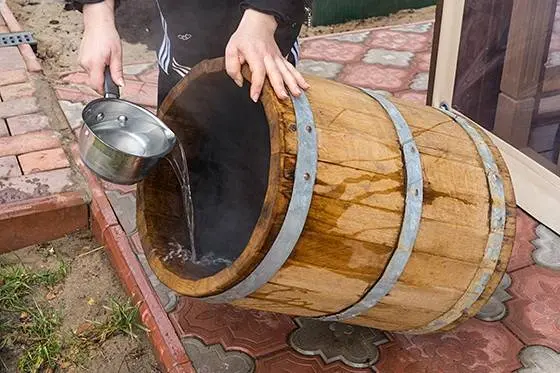
You can do otherwise: pour boiling water over the barrel and lower the red-hot stone into it. Then cover the container tightly. In the old days they said that a barrel should be thrashed before salting. You can steam a clean barrel with juniper (the best option) or dill sprigs with umbrellas. The barrel will acquire a pleasant aroma.
Well, that’s all, enjoy harvesting cabbage for the winter.










